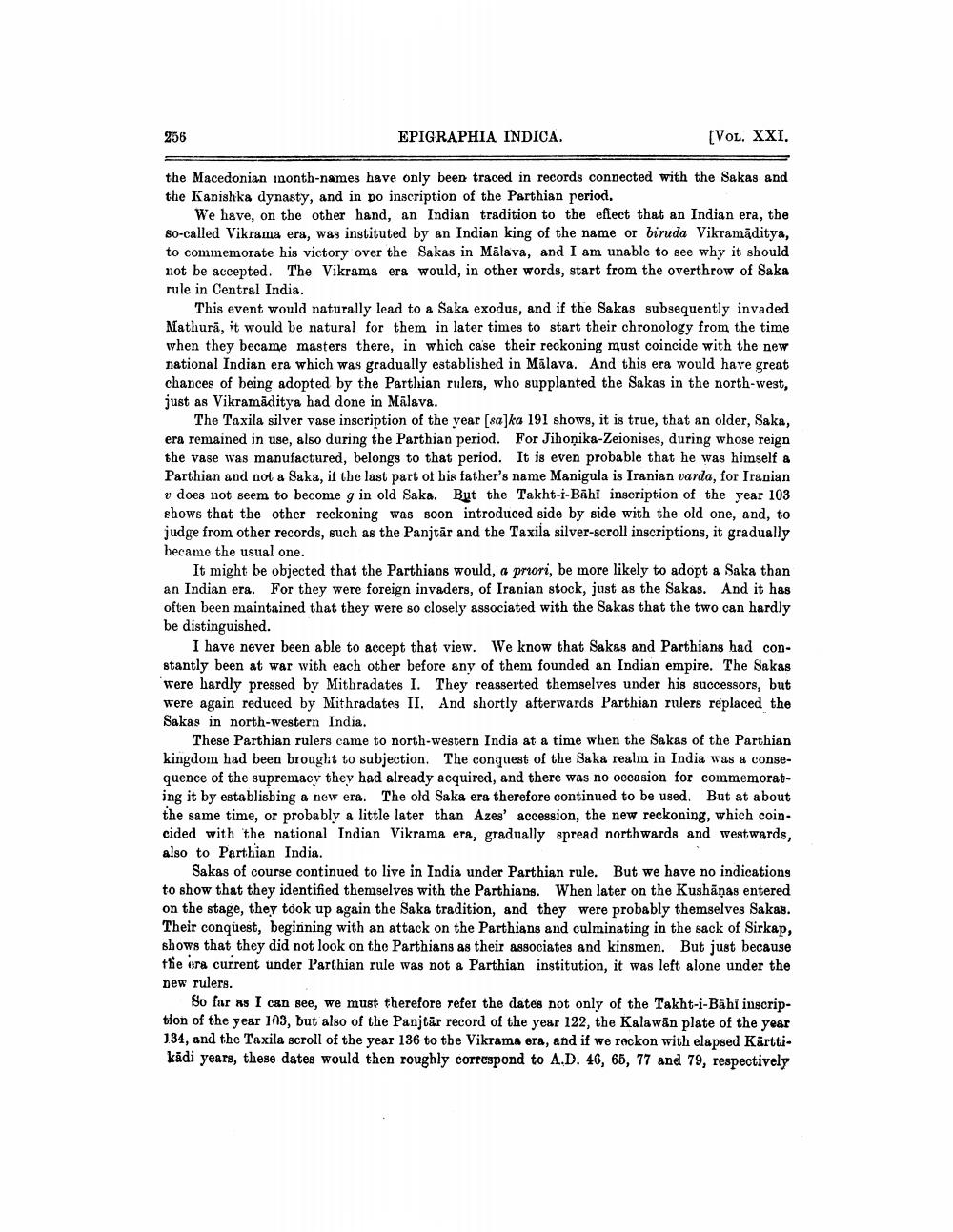________________
256
EPIGRAPHIA INDICA.
[VOL. XXI.
the Macedonian month-names have only been traced in records connected with the Sakas and the Kanishka dynasty, and in no inscription of the Parthian period.
We have, on the other hand, an Indian tradition to the effect that an Indian era, the so-called Vikrama era, was instituted by an Indian king of the name or biruda Vikramaditya, to commemorate his victory over the Sakas in Malava, and I am unable to see why it should not be accepted. The Vikrama era would, in other words, start from the overthrow of Saka rule in Central India.
This event would naturally lead to a Saka exodus, and if the Sakas subsequently invaded Mathura, it would be natural for them in later times to start their chronology from the time when they became masters there, in which case their reckoning must coincide with the new national Indian era which was gradually established in Malava. And this era would have great chances of being adopted by the Parthian rulers, who supplanted the Sakas in the north-west, just as Vikramaditya had done in Malava.
The Taxila silver vase inscription of the year [sa]ka 191 shows, it is true, that an older, Saka, era remained in use, also during the Parthian period. For Jihoņika-Zeionises, during whose reign the vase was manufactured, belongs to that period. It is even probable that he was himself a Parthian and not a Saka, if the last part of his father's name Manigula is Iranian varda, for Iranian v does not seem to become g in old Saka. But the Takht-i-Bahi inscription of the year 103 shows that the other reckoning was soon introduced side by side with the old one, and, to judge from other records, such as the Panjtar and the Taxila silver-scroll inscriptions, it gradually became the usual one.
It might be objected that the Parthians would, a priori, be more likely to adopt a Saka than an Indian era. For they were foreign invaders, of Iranian stock, just as the Sakas. And it has often been maintained that they were so closely associated with the Sakas that the two can hardly be distinguished.
I have never been able to accept that view. We know that Sakas and Parthians had constantly been at war with each other before any of them founded an Indian empire. The Sakas were hardly pressed by Mithradates I. They reasserted themselves under his successors, but were again reduced by Mithradates II. And shortly afterwards Parthian rulers replaced the Sakas in north-western India.
These Parthian rulers came to north-western India at a time when the Sakas of the Parthian kingdom had been brought to subjection. The conquest of the Saka realm in India was a consequence of the supremacy they had already acquired, and there was no occasion for commemorating it by establishing a new era. The old Saka era therefore continued to be used. But at about the same time, or probably a little later than Azes' accession, the new reckoning, which coincided with the national Indian Vikrama era, gradually spread northwards and westwards, also to Parthian India.
Sakas of course continued to live in India under Parthian rule. But we have no indications to show that they identified themselves with the Parthians. When later on the Kushānas entered on the stage, they took up again the Saka tradition, and they were probably themselves Sakas. Their conquest, beginning with an attack on the Parthians and culminating in the sack of Sirkap, shows that they did not look on the Parthians as their associates and kinsmen. But just because the era current under Parthian rule was not a Parthian institution, it was left alone under the new rulers.
So far as I can see, we must therefore refer the dates not only of the Takht-i-Bähi inscription of the year 103, but also of the Panjtar record of the year 122, the Kalawan plate of the year 134, and the Taxila scroll of the year 136 to the Vikrama era, and if we reckon with elapsed Kärttikādi years, these dates would then roughly correspond to A.D. 46, 65, 77 and 79, respectively




